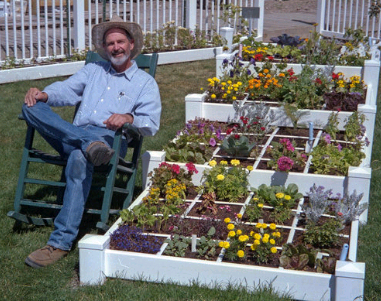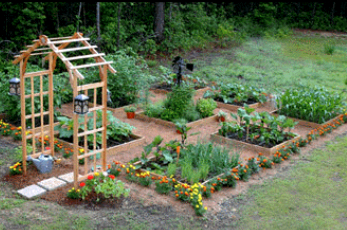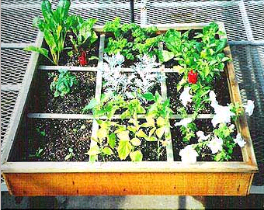
Beds and aisles in square foot gardening
 The
meat of square foot
gardening is
permanent beds, but Mel Bartholomew
didn't invent the concept. Alternative gardeners have been using
permanent beds for a long time --- for example, camellones
have been used in Central America for centuries. My
own garden is completely made up of permanent raised beds, both because our soil tends
to get waterlogged and because I want to concentrate the topsoil and
prevent soil compaction.
The
meat of square foot
gardening is
permanent beds, but Mel Bartholomew
didn't invent the concept. Alternative gardeners have been using
permanent beds for a long time --- for example, camellones
have been used in Central America for centuries. My
own garden is completely made up of permanent raised beds, both because our soil tends
to get waterlogged and because I want to concentrate the topsoil and
prevent soil compaction.
I've experimented
with a lot of permanent bed sizes
and shapes over the past few years, and the four by four square
advocated by square foot gardening is one of
my least favorite formats. I like to be able to weed and plant
and harvest
sitting down, but I can't reach the center of a four foot bed without
either leaning on the bed or standing up and bending over --- hard on
the
back. My favorite beds are three feet wide but quite long.
In fact,
the best bed shape for me seems to be a long row that I can work my way
down it, never turning a corner, pushing the wheelbarrow ahead of me as
I go.
 Which
brings me to the next flaw in Mel Bartholomew's garden design ---
the aisles. In order to fit his
garden into 20% of the space used by a traditional garden, Bartholomew
lays down 12
inch lumber and walks on this one foot wide path. I started out
with
aisles that are two feet wide, and I can barely fit my wheelbarrow down
them, often harm plants on
the ends of beds when turning corners, and can't get the lawnmower
through
some of the aisles at all. As with permanent bed widths, three
feet seems to be the magic number that keeps me from feeling cramped,
with four or five foot aisles along
main thoroughfares allowing for easier hauling.
Granted, my method uses more space than Bartholomew's, but I suspect it
saves time since I don't have to prop back up the plants I break when I
lose my balance and fall into the bed.
Which
brings me to the next flaw in Mel Bartholomew's garden design ---
the aisles. In order to fit his
garden into 20% of the space used by a traditional garden, Bartholomew
lays down 12
inch lumber and walks on this one foot wide path. I started out
with
aisles that are two feet wide, and I can barely fit my wheelbarrow down
them, often harm plants on
the ends of beds when turning corners, and can't get the lawnmower
through
some of the aisles at all. As with permanent bed widths, three
feet seems to be the magic number that keeps me from feeling cramped,
with four or five foot aisles along
main thoroughfares allowing for easier hauling.
Granted, my method uses more space than Bartholomew's, but I suspect it
saves time since I don't have to prop back up the plants I break when I
lose my balance and fall into the bed.
 Despite
being very critical of square foot gardening, I do think it has a
place. If you live in a city and have only
a tiny bit of space out front but the neighbors would yell
if you put in a traditional vegetable garden, the formal lines of
square foot gardening might fit the bill. If you work forty hours
a week and always plant a huge rambling garden, only to see it
disappear into weeds in July when you run out of time, it might be best
to scale back to a smaller garden like Bartholomew's (but, perhaps,
laid out in a more ergonomic fashion.) On the other hand, if
you're a
homesteader with lots of land and a wish to grow most of your own food,
square foot gardening probably doesn't have much for you.
Despite
being very critical of square foot gardening, I do think it has a
place. If you live in a city and have only
a tiny bit of space out front but the neighbors would yell
if you put in a traditional vegetable garden, the formal lines of
square foot gardening might fit the bill. If you work forty hours
a week and always plant a huge rambling garden, only to see it
disappear into weeds in July when you run out of time, it might be best
to scale back to a smaller garden like Bartholomew's (but, perhaps,
laid out in a more ergonomic fashion.) On the other hand, if
you're a
homesteader with lots of land and a wish to grow most of your own food,
square foot gardening probably doesn't have much for you.
(All of the images on
this page are official square foot gardens from the Square Foot
Gardening Foundation. I'm actually a bit shocked that these
are
the best images they have to offer.)
| This post is part of our Square Foot Gardening lunchtime series.
Read all of the entries: |
Want more in-depth information? Browse through our books.
Or explore more posts by date or by subject.
About us: Anna Hess and Mark Hamilton spent over a decade living self-sufficiently in the mountains of Virginia before moving north to start over from scratch in the foothills of Ohio. They've experimented with permaculture, no-till gardening, trailersteading, home-based microbusinesses and much more, writing about their adventures in both blogs and books.
Want to be notified when new comments are posted on this page? Click on the RSS button after you add a comment to subscribe to the comment feed, or simply check the box beside "email replies to me" while writing your comment.

is it just me or do the plants both look sickly and cramped? I also think 4ft is a bad design, but that is probably because I usually plant along fences, I hate to mow along fences and I need open lawn for the dog so the edges of the yard are the best place for planting. in that format, I like 2-3ft x ~30ft (3 garden ties long).
I love hearing both pros and cons --- I was hoping people would come out of the woodwork with their own experiences.
Tracy, I'm so impressed by your CSA! You'll have to let me know how it goes (and how you like the square foot beds). We ran a small CSA one year, but then decided that we'd rather have the extra food in our freezer that winter rather than the cash in our wallet. But I could easily have seen us go the other way.
Anonymous --- I agree that the plants look really sad. If you go to the site, you'll notice that I picked the best pictures there, not the worst. I'd love to see other people send me to some square foot gardening pictures that look a bit better. Your bed layout sounds perfect --- I actually feel like three feet is too wide sometimes.
Anna
Send me you email address and I'll send some you better square foot garden pictures
Ron
m0j0d17@gmail.com
btw: love your blog
I've worked in my garden and a community garden for a few years. I tried the square foot method but I've come to the same conclusions you've come to.
It is hard to work deeply inside the 4x4 squares if you're sitting down. It's also hard to bring in materials to the area once it's established.
If the farmers are working in a very constrained space it certainly makes sense, but I would rather dig my walking rows as you've described than spend so much money making paths from wooden planks, mulch or pavers. I tried using brick as rows and that ended up with me weeding the rows more than the garden beds. Large pavers worked okay when I could get them for free, but they are expensive once you start a large garden intended to provide the majority of your food sources.
In some senses it's a shame as I liked the sort of OCD attention to every single square of plants but as I scaled up I've realized it's just not practical. Thank you for the precise measurements(and the easier way of measuring by shovel handle size) as I'll be using this as a guide on my planting this year. At least then I'll be able to mow the rows and transport items in and out of the garden more readily.
I'll also be glad to just mark one section as a section of corn rather than keeping track of every single square.
Glad to know I'm not alone.
I really didn't cherry pick bad images for this post --- the ones I included were the best I could find on that website at the time. I'd be glad to see some better images. You might be interested in the square foot gardening rebuttal by one of our readers.
If you read further on our blog, you'll find that I'm not advocating typical row gardening and that I think intensive gardening has a lot of advantages in the home garden. However, square foot gardening also has a lot of disadvantages that can be overcome by less trendy types of intensive gardening.